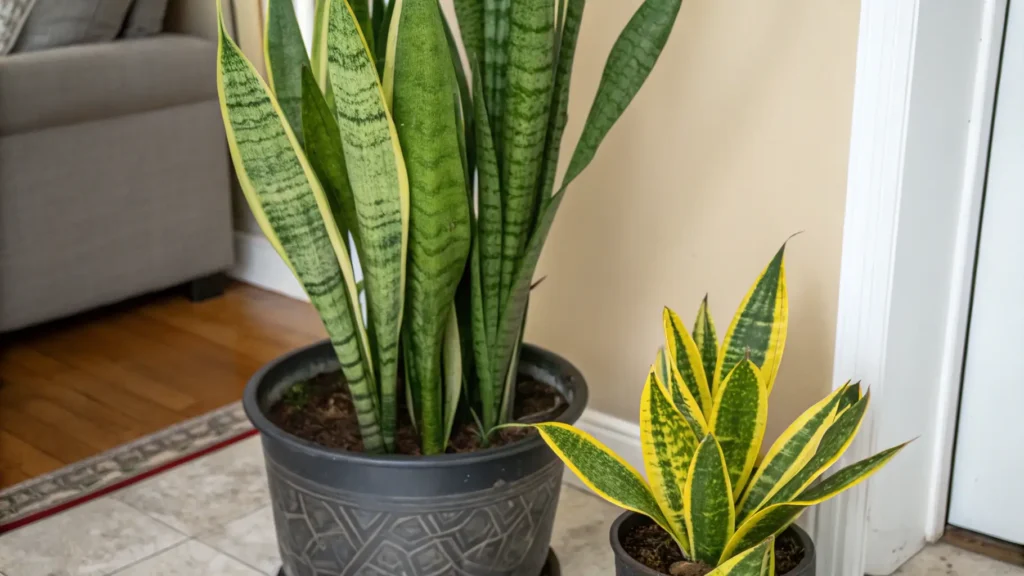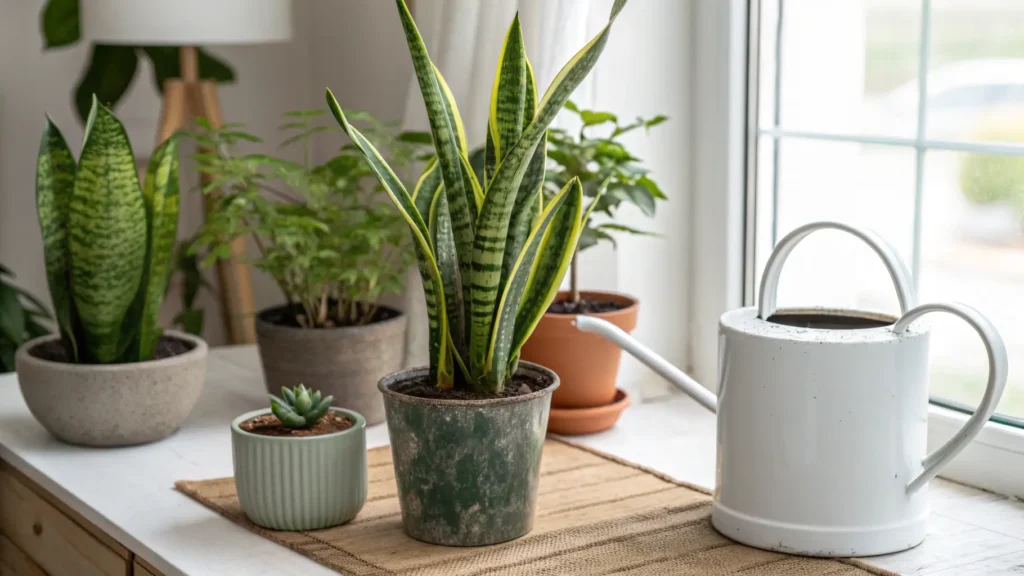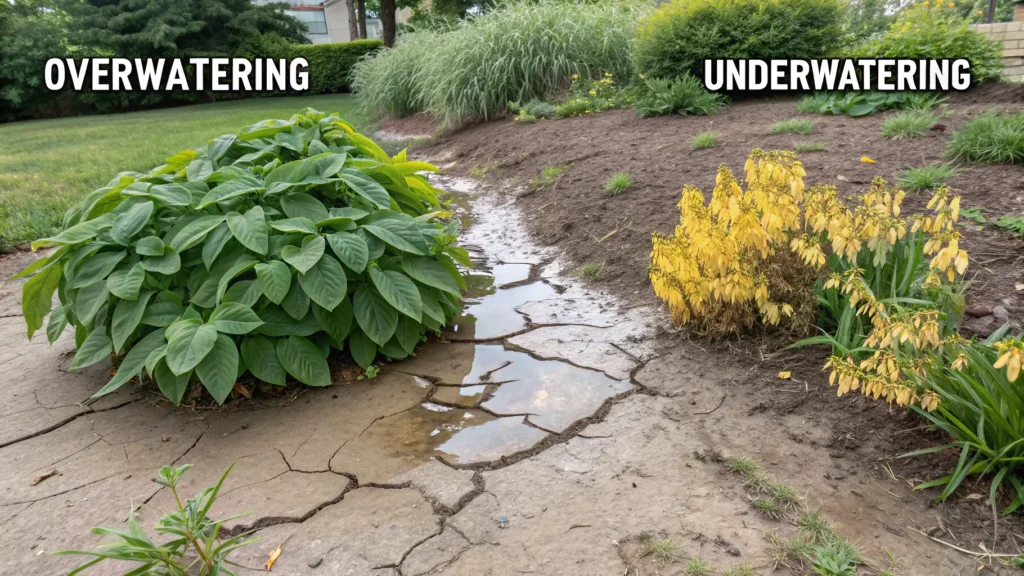The biggest myth about watering your snake plant? That they thrive on neglect. While these resilient Sansevieria plants tolerate drought incredibly well, truly mastering how to water a snake plant is the single most critical factor for their long-term health and vibrant growth. Get it right, and your snake plant will flourish; get it wrong, and you’re likely to face issues like dreaded snake plant root rot or wilting leaves.
This comprehensive guide is designed to empower you with the exact knowledge and techniques needed to water your snake plant perfectly, every time. We’ll demystify the “when” and “how,” dive into nuanced factors like water quality and pot type, and provide expert troubleshooting for common problems. By the end, you’ll be able to confidently nurture a thriving, healthy Sansevieria that stands tall and proud.

TABLE OF CONTENTS
The Foundation: Why Watering Your Snake Plant Matters (And Why It’s Tricky)
Snake plants, scientifically known as Sansevieria (now officially Dracaena trifasciata), are among the most popular houseplants, celebrated for their architectural beauty and air-purifying qualities. Despite their reputation as indestructible, watering snake plant specimens is the leading cause of problems for most owners. The challenge lies in understanding their unique biology.
These plants are succulents, meaning they store water in their thick, fleshy leaves. This adaptation allows them to endure long periods without water in their native arid environments. However, this same trait makes them incredibly susceptible to overwatering snake plant issues, as their roots can quickly drown and rot in constantly wet soil. Conversely, extreme underwatering snake plant can also lead to stress, though it’s far less common. This guide will help you strike the perfect balance, ensuring your Sansevieria thrives.
The Golden Rule: When to Water Your Snake Plant
The most crucial advice for watering snake plant varieties is deceptively simple: always let the soil dry out completely between waterings. This fundamental principle prevents root rot and mimics their natural drought-tolerant habitat. But how often to water snake plant exactly? The frequency isn’t fixed; it’s about observing your plant and its environment.
The Finger Test: Your Most Reliable Tool
The “finger test” is the classic and most accessible method to determine if your snake plant needs water.
- Insert your finger: Push your index finger two to three inches deep into the soil. For smaller pots, go about halfway down.
- Feel the moisture: If the soil feels damp or cool at this depth, wait a few more days and check again.
- Water when dry: If the soil feels completely dry, crumbly, and warm, it’s time to water your snake plant.
Using a Moisture Meter: For Precision Watering
For those who prefer a more objective measure, a moisture meter can be a valuable tool.
- Insert the probe: Gently push the probe two-thirds of the way into the soil, avoiding roots.
- Read the gauge: Different meters have different scales, but generally, you want to water when the reading indicates “dry” or a low number (e.g., 1-2 on a scale of 1-10).
- Beware of pitfalls: Remember that moisture meters measure moisture, not water. Soil composition can sometimes give false readings. Always cross-reference with the finger test, especially when you’re first learning
check soil moisture snake planttechniques.
Check the soil with your finger – great method
Visual Cues from Your Plant
Your snake plant will also give you subtle hints about its snake plant watering frequency:
| Ready to Water (Thirsty) | Overwatered (Trouble) |
|---|---|
| Slightly curled or softer leaves: Not mushy, but less rigid. | Yellowing leaves (snake plant yellow leaves watering): Especially at the base. |
| Crispy leaf tips: A sign of prolonged dryness. | Mushy, soft, or squishy leaves/stems: A clear sign of root rot. |
| Very light pot: Soil shrinks from the sides, pot feels significantly lighter. | Foul smell from soil: Indicates rotting roots. |
Step-by-Step: The Best Ways to Water Your Snake Plant
Once you’ve determined your snake plant is thirsty, how much water for snake plant and what’s the best technique? There are two primary methods, each with its benefits.

Top Watering Method
This is the most common and often recommended method for how to water a snake plant.
- Pour slowly and thoroughly: Use a watering can to slowly pour water over the surface of the soil, ensuring even saturation.
- Water until drainage: Continue
watering snake plantuntil you see water freely draining from the bottom holes of the pot. This ensures that the entire root ball is moistened. - Allow to drain completely: Let the pot sit for 15-30 minutes, allowing all excess water to drain out.
- Empty the saucer: Crucially, empty any standing water from the saucer. Allowing your snake plant to sit in water will lead to
snake plant root rot. This step is vital for goodsnake plant soil drainage.
Bottom Watering Method
Can you bottom water snake plant? Absolutely! This method encourages stronger root growth and prevents water from sitting in the plant’s rosette, which can cause rot.
- Prepare a basin: Fill a basin or sink with a few inches of room-temperature water.
- Place the pot: Set your snake plant’s pot (with drainage holes!) directly into the water.
- Allow absorption: Let the plant soak for 15-30 minutes, or until the top layer of soil feels moist to the touch. The plant will absorb water upwards through the drainage holes.
- Remove and drain: Take the pot out of the basin and place it on a saucer to let any remaining excess water drain away for another 10-15 minutes.
Misting & Leaf Wiping
Do snake plants like to be misted? Generally, no. Snake plants are desert plants and do not benefit from misting. High humidity on their leaves can actually encourage fungal issues. Instead of misting, periodically wipe your snake plant’s leaves with a damp cloth. This removes dust, allowing the plant to photosynthesize more efficiently and keeping its foliage looking its best.
Factors That Dictate Your Snake Plant’s Watering Schedule
While the “dry soil” rule is universal, the time it takes for soil to dry varies significantly. Understanding these influencing factors is key to developing a personalized snake plant watering schedule.
Light Levels
Light is arguably the most significant factor affecting how quickly your plant uses water.
- Bright, indirect light: Plants in brighter conditions photosynthesize more, transpiring water more rapidly. You’ll likely need to water more frequently, perhaps every 2-4 weeks.
- Medium light: A balanced approach, watering might be needed every 3-5 weeks.
- Low light: Plants in low light environments (
watering snake plant in low light) use very little water. Overwatering is a huge risk here. Expect to water as infrequently as once every 4-8 weeks, or even longer in deep shade.
Pot Material & Size
The material and size of your pot directly impact moisture retention.
- Terracotta pots: Porous terracotta wicks moisture away from the soil, allowing it to dry out faster. If you’re
watering snake plant in terracotta pot, you might water slightly more often. - Plastic or glazed ceramic pots: These materials retain moisture for much longer. Be extra cautious with your
snake plant watering frequencyto avoid waterlogged soil. - Pot size: A plant in a pot that’s too large will hold excess soil, which takes longer to dry, increasing overwatering risk. Conversely, a root-bound plant in a small pot might dry out surprisingly quickly.
Soil Type & Drainage
The right soil mix is fundamental for proper snake plant soil drainage.
- Ideal mix: Use a well-draining succulent or cactus mix. This typically includes components like perlite, coarse sand, or pumice to prevent compaction.
- Avoid dense soils: Heavy, dense potting soil designed for moisture-loving plants will retain too much water, leading to
snake plant root rot. - DIY
best soil for snake plantmix: A good recipe is two parts standard potting soil, one part perlite, and one part coarse sand.
Environmental Humidity & Airflow
- High humidity: In very humid environments, water evaporates from the soil more slowly, requiring less frequent watering.
- Low humidity/Dry air: In dry climates or homes with forced-air heating/AC, soil will dry out faster, potentially necessitating slightly more frequent watering.
- Good airflow: Circulation helps dry out the topsoil, but stagnant, humid air around the plant can be a breeding ground for fungus and pests, especially if the soil is consistently wet.
Seasonality & Temperature
Your snake plant’s watering needs will change drastically throughout the year.
- Summer (Growing Season): During warmer months, snake plants are actively growing and metabolizing more water. Expect to water more frequently, perhaps every 2-4 weeks, depending on light and temperature (
summer watering snake plant). - Winter (Dormancy): In colder, darker months, your snake plant enters a period of dormancy, significantly slowing its growth and water uptake. This is when
winter watering snake plantis trickiest; reduce frequency drastically, often to once every 4-8 weeks, or even less. Err on the side of underwatering in winter. - Indoor temperatures: Consistently warm indoor temperatures might mean slightly more frequent watering than a cooler room, but always prioritize dry soil.
Water Quality & Your Snake Plant: What You Need to Know
The type of water you use can subtly impact your snake plant’s health over time. While often overlooked, what kind of water for snake plant is a valid concern.
- Tap water considerations:
- Chlorine and Fluoride: Most municipal tap water contains chlorine and sometimes fluoride. While generally safe in small amounts, high concentrations can lead to brown leaf tips over time. Letting tap water sit out for 24 hours allows chlorine to evaporate.
- Mineral buildup: Hard water, rich in minerals like calcium and magnesium, can leave white crusty deposits on the soil surface and pots. Over time, this buildup can affect soil pH and nutrient absorption.
- Filtered water: A simple activated carbon filter (like those in Brita pitchers) can remove chlorine and some impurities, making tap water safer and gentler for your plant.
- Distilled or rainwater: These are the purest forms of water, free from salts and chemicals. While not strictly necessary, using them can prevent mineral buildup and is ideal for sensitive plants. If collecting rainwater, ensure it’s clean and free of pollutants.
- Importance of room temperature water: Always use room temperature water. Cold water can shock the roots of your snake plant.
Improving Tap Water Quality for Plants
You don’t necessarily need fancy filtration to keep your snake plant happy:
- Let it sit: Fill your watering can the day before you plan to water and let it sit uncovered. This allows chlorine to dissipate.
- Simple filtration: A basic water filter pitcher works wonders.
- Occasionally flush: Once or twice a year, thoroughly flush the soil with distilled or rainwater to rinse away any accumulated mineral salts.
Troubleshooting Watering Issues: Overwatering vs. Underwatering
Even with the best intentions, watering issues can arise. Knowing the signs and how to how to revive an overwatered snake plant or how to fix underwatered snake plant is crucial.

Signs of Overwatering (and snake plant root rot)
Overwatering is the number one killer of snake plants. It leads to suffocation of the roots, which then begin to rot.
- Symptoms:
Snake plant yellow leaves watering, especially at the base.- Leaves becoming soft, mushy, or squishy to the touch.
- Dark, water-soaked spots on leaves or stems.
- Foul, rotten smell coming from the soil.
- Stunted growth or sudden collapse of the plant.
- Immediate recovery steps:
- Stop watering immediately: Do not give it another drop.
- Air dry: Remove the plant from its pot. Gently brush off as much wet soil as possible.
- Inspect roots: Look for
snake plant root rotroots will be black, mushy, and easily break apart. Healthy roots are firm and white or light tan. - Prune rot: Using sterilized scissors, cut away all affected roots until you reach healthy, firm tissue. If all roots are rotted, consider taking leaf cuttings for propagation.
- Repot: Repot into a clean pot with fresh, well-draining soil. Do not water for at least a week, allowing the roots to heal.
Signs of Underwatering
While less common, extreme underwatering can also harm your snake plant.
- Symptoms:
- Leaves becoming crispy, dry, and sometimes wrinkly or shriveled, particularly at the tips.
- Browning leaf tips or edges.
- The soil pulling away from the sides of the pot.
- Stunted growth.
- The plant feels incredibly light when lifted.
- Recovery steps:
- Thorough soaking: Give the plant a deep, thorough watering (either top or bottom method) until water drains from the bottom.
- Consistent follow-up: Ensure you resume a proper
snake plant watering schedule, checking the soil regularly. While the leaves might not fully recover their original plumpness, new growth should be healthy.
Prevention is Key
The best cure is prevention. Always remember:
- Let the soil dry out completely.
- Ensure excellent drainage.
- When in doubt, wait one more day.
Special Watering Scenarios & Advanced Tips
Beyond the basics, certain situations require specific Sansevieria watering strategies.
Watering Newly Propagated Snake Plants
- Cuttings rooted in water: Once roots are 1-2 inches long, transfer to soil. Water lightly after potting, then let the soil dry completely before the next watering, just like a mature plant.
- Soil-rooted propagations: Keep the soil slightly more consistently moist than a mature plant for the first few weeks, but never soggy. Once established (new growth appears), transition to the standard “dry out completely” rule.
Watering After Repotting
After repotting, wait 5-7 days before watering after repotting snake plant. This allows any damaged roots to callous over, preventing rot. When you do water, do so thoroughly.
Snake Plants in Low Light
For snake plants in very low light conditions (watering snake plant in low light), the risk of overwatering skyrockets.
- Extend intervals: Significantly extend the time between waterings. It’s not uncommon for a low-light snake plant to only need water once every 6-10 weeks.
- Ultra-dry test: Ensure the soil is bone dry, even deeper than usual, before watering.
Vacation Watering Strategies
Planning to be away? Don’t fret about your snake plant.
- Water before you go: Give it a thorough watering right before you leave.
- Move to lower light: Relocate your snake plant to a cooler, lower-light area of your home. This slows down its metabolism and water usage.
- Avoid self-watering solutions: Most self-watering globes or wicking systems keep the soil too consistently moist for snake plants, increasing rot risk. They are generally not recommended for Sansevieria.
Expert Spotlight: Vacation Watering Tip “For snake plants, less is more when you’re away. They can easily go for weeks without water. A good soak before you leave, and moving them to a slightly shadier spot, is usually all they need for a worry-free vacation.”
Quick Reference & FAQs for Snake Plant Watering
Here are some quick tips and answers to common questions about Sansevieria watering:
Quick Tips for Busy Plant Parents
- When in doubt, don’t water.
- Use the finger test.
- Ensure drainage holes are clear.
- Empty saucers immediately.
- Reduce watering drastically in winter.
Curated FAQs
How often to water snake plant?Let the soil dry out completely between waterings, typically every 2-6 weeks depending on light, season, and environment.What kind of water for snake plant?Room temperature tap water is usually fine. Let it sit for 24 hours to dissipate chlorine. Filtered water, distilled water, or rainwater are even better to prevent mineral buildup.Can you bottom water snake plant?Yes! Bottom watering is an excellent method that encourages strong root growth and prevents water from pooling in the plant’s rosette.How much water for snake plant?Water thoroughly until water drains from the bottom of the pot. Then, ensure all excess water is removed from the saucer.How to tell if snake plant needs water?Perform the finger test: if the soil is completely dry 2-3 inches deep, it’s time to water. You might also notice slightly softer, less rigid leaves.Do snake plants like to be misted?No, snake plants do not typically benefit from misting. They prefer dry conditions.Can I use ice cubes to water my snake plant?While it provides slow release, it’s generally not recommended. Cold water can shock the roots, and it doesn’t always provide the thorough, even saturation that a good soak does.
Conclusion: Master the Art of Snake Plant Watering
Congratulations! You now possess the definitive knowledge to confidently how to water a snake plant for optimal health. The true art lies in observation: understanding your plant’s specific needs based on its environment, pot, and the season. With patience and attention, you can avoid common pitfalls and unlock the full potential of these magnificent, low-maintenance plants.
Embrace the joy of seeing your Sansevieria thrive, growing stronger and more beautiful with each passing season. Don’t be afraid to experiment slightly and adapt these guidelines to your unique circumstances. Your snake plant care guide journey doesn’t end here continue to explore and learn! Share your snake plant success stories and vibrant Sansevieria photos with our community!
